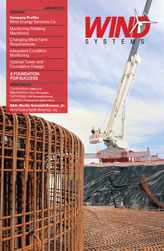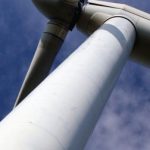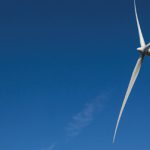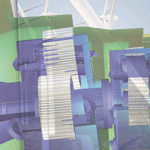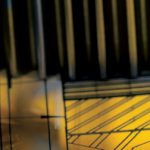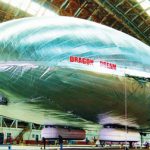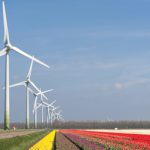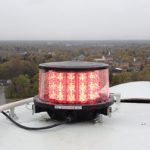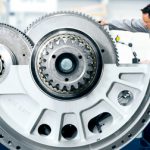The growth of wind power and its sustainability depends on good return on investment. The goal everywhere is minimizing cost/kWh. Several strategies are emerging to attain this goal:
• Improve turbine efficiency;
• Access better wind conditions (high mean wind speed);
• Improve turbine output;
• Reduce cost of acquisition and construction;
• Reduce cost of maintenance.
Three of these strategies are answered directly by the implementation of greater hub height. All of them are influenced by optimal tower design. Overall, the economics show a shorter payback is obtainable by employing a larger tower.
The Challenges
Significant structural challenges are connected with implementing higher wind towers. Higher towers require more massive and costly foundations. Flexibility of the high tower must be addressed. It is more difficult to achieve the natural frequency required for proper turbine operation. These factors add significantly to the up-front engineering burden during the design stage.
Transportation of larger tower pieces poses a special problem. Most highways have a 4.5-m width limitation, and vehicles handling long sections find it difficult to negotiate the curving roads that commonly serve remote wind farm locations. Construction time for higher towers can be longer, lengthening return on investment by delaying the commencement of revenue bookings.
Design Strategies
Designers are turning to a variety of new technologies to minimize costs connected with detail design, tower components and foundations. One alternative is employing precast concrete. Hybrid precast concrete/steel towers are proving attractive for several reasons. They offer easy transport of manageably sized component pieces, rapid erection, high strength and stiffness, the prospect of reduced maintenance and an attractive lifetime cost. Some designers are using cast-in-place hybrid towers with concrete 60 m high and 8 m diam. at the base. Others are employing prefabricated concrete rings bolted together on-site and post tensioned using external tendons. Some precasters have a continuous taper tower design, where the diameter at ground level approximates that of steel.
With these conventional diameter designs, the challenges of tower frequency and load concentration at the foundation remain. Foundations are necessarily thick, massive, and expensive to construct.
The Atlas CTB
One design has emerged that addresses the challenges with foundation loading, complexity and cost challenges. This is the Tindall Atlas CTB™ Tower Base (Figure 1), a patent pending design featuring a flared precast concrete base section. The Atlas CTB comprises the lower 40m of hybrid tower system that serves as an elevated platform to support conventional steel monotowers 80m to 100m in height to achieve hub heights to 140 meters and designed for wind turbines from 1.5MW to 3MW and up.
The Atlas CTB truncated cone base assembly is composed of 12 or more stave units. The multiple precast concrete staves are erected, assembled and post-tensioned on site. The staves are captured by an outer precast ring system at the tower transition region. This concrete transition ring controls the stave tops and provides an uninterrupted transition from the truncated cone base to circular precast concrete tubular sections that form the upper part of the Atlas CTB and provide the support for the steel tower.
The vertical staves that form the truncated cone base are identical for each assembly (Figure 2); they are of a size that makes them easily transportable in pairs by rail (Figure 3, Figure 4). Most importantly, the modular, multiple stave design affords design simplicity and scalability to accommodate towers of various height and turbine size. With increasing numbers of staves, the base diameter increases to accommodate the loads imposed by greater heights and larger turbines.
Foundation Comparison
The larger footprint and lower foundation pressure characteristic of the wide Atlas CTB Tower Base does away with the massive, costly foundations required by narrow diameter base sections. The 0.75-m to 1-m-thick ring foundation (Figure 5) accommodates loading using 50-60 percent less concrete than other tall tower options.
With no high-mass concrete pours, this contractor friendly ring foundation poses no thermal cracking concerns during curing. The wide load distribution makes the simple ring foundation less sensitive to settlement throughout its service life and provides for improved dynamic performance that is less sensitive to the prevailing soil conditions.
Strength Development
Post-Tensioning. The composite transition region is vertically and circumferentially post-tensioned together, resulting in a bi-axially compressed condition. No tension is present under applied loads. Multiple pairs of tendons are passed down through the transition assembly, the stave beneath, the neighboring stave, then back up to its anchorage point (Figure 6). These looped tendons provide precompression (increased shear capacity) of the grouted stave-to-stave joints. Moreover, additional circumferential tendons are employed at multiple shear key locations situated lower in the conical tower base. Altogether, the combination of tendons gives the Atlas CTB Tower Base outstanding resistance to all anticipated bending, shear and torsional forces.
Strength Benefits. The post-tensioned stave/ring system produces a high tower frequency. The result is a tower with superior dynamic properties, thanks to the post-tensioning process and the natural dampening qualities of precast concrete.
Economic Advantages
The Atlas CTB Tower Base design concept promises significant economic advantages relative to installed cost, schedule compression, extended life cycle and reduced maintenance.
Site Work. The onsite construction process is significantly shorter with the Atlas CTB Tower Base design. The structure is composed of factory or site-manufactured pre-cast components. This repetitive, precast manufacturing process reduces field construction work and the concrete tower construction becomes principally erection instead of field construction. No welding and requisite testing are necessary. Apart from the foundation, no concrete forms have to be built. The large amounts of waste typical with construction sites are not generated. Pieces can be placed using standard cranes.
Maintenance Factors. Low maintenance over an anticipated 50-year service life enhances the economic attractiveness of the Atlas CTB Tower Base. There is no periodic tightening required since the primary connections are post-tensioned throughout the structure and at the foundation. The structure needs no painting over its lifetime. Given the rigidity and superior dynamic properties of the Atlas CTB, the service life of the turbine and related components should be extended.
The Atlas CTB Tower Base is designed as an answer to the specific challenges encountered in the need for higher unit power output in the wind farm, with enhanced return on investment and expanding the wind resource footprint by increasing hub heights and creating viable wind development in low wind speed regions. Furthermore, with its selectable number of staves for increased base diameters, the design is scalable to accommodate the loads presented by higher hub heights and the next generation of high-output turbines.



















